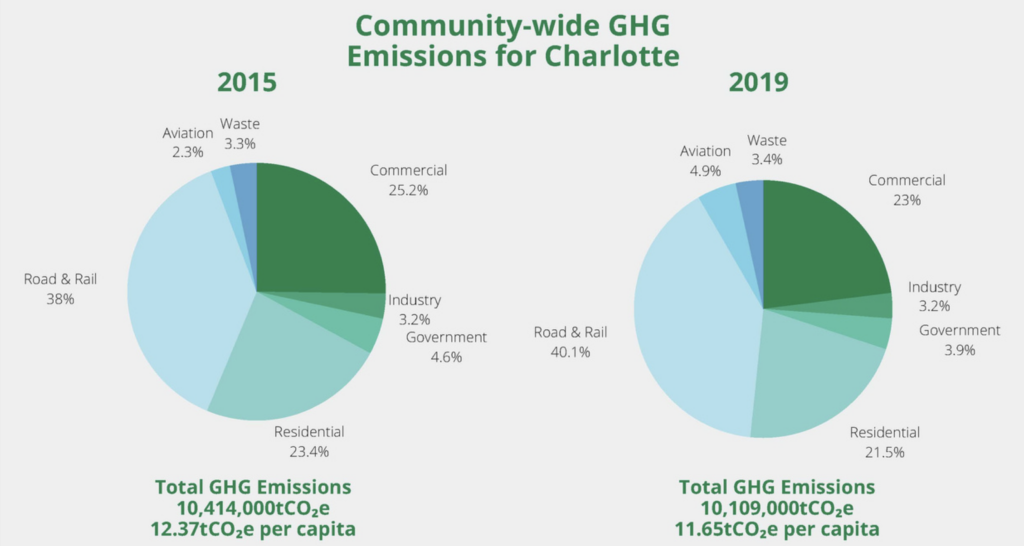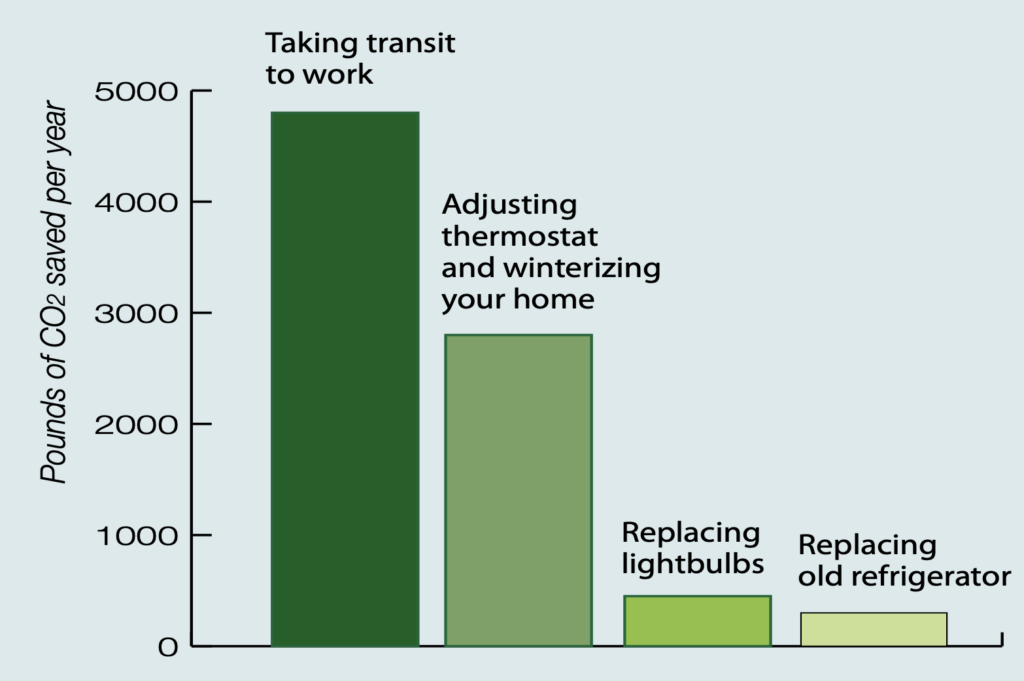What Charlotte’s Strategic Mobility Plan means for the environment
Over the next few weeks, we’ll be covering how the Strategic Mobility Plan could benefit Charlotte’s “three E’s”: the environment, equity, and economy. Up first, we’ll focus on the environment and how the plan could reduce our greenhouse gas emissions and help Charlotte grow more sustainably.
On June 27, Charlotte City Council passed the Strategic Mobility Plan. We celebrate this as a significant step toward creating a city with safe and equitable mobility choices.
The plan is designed to improve Charlotte’s public transportation system and make the city safer to navigate for pedestrians, cyclists, and transit riders. Among the changes outlined are an expanded rail network, more sidewalks, safer bike lanes, and a greater emphasis on equitable growth.
The Strategic Mobility Plan also sets an ambitious 50-50 mode share goal, which aims to reduce the share of people driving to work alone from 76% to 50% by 2040. This will be crucial to helping Charlotte become a low-carbon city by 2050, as outlined in the Strategic Energy Action Plan.
Charlotte is a car-dependent city with some of the longest commutes
Given the sprawling nature of Charlotte, most residents rely on cars to get around. Pre-pandemic, 76% of Charlotte commutes were made in single-occupancy vehicles, meaning most residents drove alone to work.
In 2018, the mean travel time to work for Charlotteans was about 25 minutes, the longest in the state. Just under 40% of Charlotte residents had an even longer drive, commuting over 30 minutes each day.
Extra car miles are leading to more emissions in North Carolina
All of this extra time in our cars is adding up. In just the past 20 years, the average annual vehicle miles traveled in North Carolina has increased by almost 30 billion miles, according to a state Department of Transportation study. That’s enough to wrap around the world more than 1 million times.
Simply put, more miles on the road means more carbon emissions. The transportation sector is now the largest contributor to greenhouse gas (GHG) emissions in Charlotte, accounting for 40% of our total emissions in 2019, according to the city’s Strategic Energy Action Plan. That’s well over the national average for transportation, which clocks in at just 27%. In fact, North Carolina ranks ninth highest in the U.S. for total transportation emissions, according to the state Department of Environmental Quality.

(Pictured above: Page 32 of the Strategic Energy Action Plan Three Year Report.)
(Pictured above: Page 32 of the Strategic Energy Action Plan Three Year Report.)
Cars contribute to climate change, and Charlotte is feeling the effects
Driving so much takes a heavy toll on our environment. Burning gas in cars releases carbon dioxide, ozone, and other pollutants that contribute to the buildup of greenhouse gasses in the atmosphere. These gasses trap heat, increasing temperatures and driving climate change across the globe.
Climate change is already being felt in Charlotte, and its impacts will disproportionately affect people with low incomes and existing health conditions. If we don’t slow our greenhouse gas emissions, we can expect sea level rise on the coast, more days with dangerous heat, and more extreme weather events. Severe storms will cause flash flooding and damage to urban areas, and intense droughts will increase the risk of wildfires and agricultural loss.
Car-free commutes are a great way to reduce your carbon footprint
Cutting down on personal automobile travel will be essential to reducing greenhouse gas emissions and preventing the worst impacts of climate change. The Strategic Mobility Plan could help Charlotte do exactly that, more than doubling the number of car-free commutes.
Walking, biking, or taking public transit reduces the number of cars on the road, resulting in fewer vehicle miles traveled and less emissions produced. Fewer cars during rush hour would also ease congestion, helping cars already on the road be more fuel efficient.
In fact, commuting without a car may be one of the best things Charlotteans can do to make their carbon footprint smaller. By taking public transportation instead of routinely taking a car for a 20-mile commute, you could cut your annual carbon emissions by 4,800 pounds a year, according to the American Public Transit Association. And compared to other common household actions to be more sustainable, taking transit to work is one of the most effective options.

(Pictured Above: Carbon savings of taking public transportation compared to other energy-saving household activities. Source: Public Transportation Reduces Greenhouse Gasses and Conserves Energy.)
(Pictured Above: Carbon savings of taking public transportation compared to other energy-saving household activities. Source: Public Transportation Reduces Greenhouse Gasses and Conserves Energy.)
Charlotte’s Strategic Mobility Plan will increase access to greener transportation options
As surveys for the Strategic Mobility Plan found, most Charlotte-area residents want greener ways to commute. However, many communities do not yet have access to efficient and safe alternatives to driving.
If fully implemented, the Strategic Mobility Plan will increase the options available to Charlotteans, providing safer bike lanes, better-connected sidewalks, and expansions to the Charlotte Area Transit System’s bus and rail services. These investments will be crucial to building a more sustainable and less car-dependent city.
(For more detail, see our previous posts on how the Strategic Mobility Plan would specifically improve commutes for cyclists and public transit riders).
These investments will help charlotte grow more sustainably
In addition to immediately reducing auto emissions, investing in transit infrastructure will also make Charlotte’s land use more efficient in the long run.
Like many cities across the country, Charlotte faces the challenges of urban sprawl. When affordable housing is far from workplaces and essential services, people have to drive much longer to meet their everyday needs, contributing to transportation emissions.
When implemented in conjunction with better land use and development through the Unified Development Ordinance, the Strategic Mobility Plan could help combat sprawl by supporting more residents’ ability to live, work, and spend time in areas with walkable, mixed-use development. Denser cities are easier to navigate without a car and are also able to maximize the efficiency of their public transportation systems.
With 385,000 more people projected to live in Charlotte by 2040, it’s important that we make changes to our transportation network now so we can continue to grow sustainably.
The Strategic Mobility Plan has passed, but there’s still work to be done in Charlotte
City Council’s vote to pass the Strategic Mobility Plan has the potential to change the way Charlotte lives and travels for the better. But to actually build out the full vision of the plan, we still need to secure local funding, and City Council needs to pass crucial supporting policy, starting with the Unified Development Ordinance.
The Strategic Mobility Plan is just part of a larger network of plans for Charlotte’s growth. It supports Charlotte’s 2040 Future Comprehensive Plan and is informed by the 2040 Policy Map, which determines what can be built where.
So far, all of these plans are exactly that: just plans. To build the street types laid out by the Strategic Mobility Plan, we need the UDO as a tool to guide land use and make it easier to get around.
As Charlotte’s main land-use advocacy organization, we will continue to advocate for the Strategic Mobility Plan to guide decision-making in Charlotte. But we can’t do it alone.
So how can you get involved? For starters, keep tabs on opportunities to advocate for funding and the UDO in your area. Sign up for our newsletter, which will update you on important meetings and opportunities to give input. Continue to support the Strategic Mobility Plan and make sure that it reaches its potential to shape Charlotte for the better.
Thanks for reading!
As a nonprofit, community support is essential for us to keep doing what we do — including providing free articles like this. If you found this article helpful, please consider supporting Sustain Charlotte.
Want to stay in the loop? Subscribe to our weekly newsletter and follow us on Instagram, Facebook, and Twitter.
